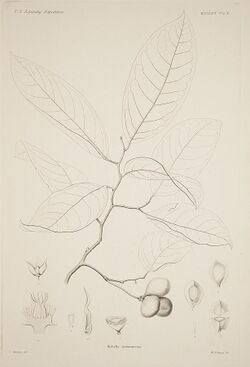Biology:Goniothalamus monospermus
| Goniothalamus monospermus | |
|---|---|

| |
| Botanical illustration of Goniothalamus monospermus (using basionym Richella monosperma) showing leavers, branches, flower parts, fruit and seeds.[1] | |
| Scientific classification | |
| Kingdom: | Plantae |
| Clade: | Tracheophytes |
| Clade: | Angiosperms |
| Clade: | Magnoliids |
| Order: | Magnoliales |
| Family: | Annonaceae |
| Genus: | Goniothalamus |
| Species: | G. monospermus
|
| Binomial name | |
| Goniothalamus monospermus (A.Gray) R.M.K.Saunders
| |
| Synonyms | |
|
Oxymitra monosperma (A.Gray) A.C.Sm. | |
Goniothalamus monospermus is a species of plant in the family Annonaceae. It is native to Fiji.[3] Asa Gray, the American botanist who first formally described the species using the basionym Richella monosperma, named it after its fruit's solitary seed (Latinized forms of Greek μόνος, mónos and σπέρμα, spérma) which have notable wing-like fringes.[4][5]
Description
It is a tree reaching 15 meters in height. Its thin to leathery, hairless, elliptical to oblong leaves are 12.7-17.7 by 5.1-7.6 centimeters. The leaves come to a short tapering tip and have a rounded or shallowly pointed base. The leaves have slender veins that form a network pattern. Its solitary flowers are born on peduncles that are 2.5 centimeters or longer and are positioned axially or opposite leaves. Its sepals form a three-lobed calyx. Its flowers have 6 greenish-yellow petals with orange highlight arranged in two rows of three. The oval outer petals are 1.7 centimeters long with tips that slightly taper to a point. The oval inner petals are 0.8 centimeters long. The flowers have numerous stamen in several rows. The stamen have short filaments, and the tissue connecting the lobes of the anthers is thickened and terminates abruptly at its apex. The anthers dehisce longitudinally. Its flowers have roughly 20 pistils. Its oblong ovaries are about as long as the stamen and contract into a thick styles, which are also as long as the stamen. The styles have a longitudinal channel and their stigma occupy the length of their inward facing surface. Its yellow, oval fruit are 3.8 by 2.5 centimeters. Each fruit has a solitary seed that is an 2.5 long and almost as wide. The oval seeds are flat on one side and keeled on the other. The brown, leathery surface of the seeds forms a wing-like margin with an offset notch at the base.[4][6]
Reproductive biology
The pollen of G. monosperma is shed as permanent tetrads.[7]
Habitat and distribution
It has been observed growing in dense forests at elevations of 100–1,500 meters.[6]
References
- ↑ Gray, Asa (1856). United States Exploring Expedition. Atlas Botany Phanerogamia. Philadelphia: C. Sherman & Sons. p. plate 2. https://www.biodiversitylibrary.org/item/134851.
- ↑ IUCN SSC Global Tree Specialist Group.; Botanic Gardens Conservation International (2020). "Goniothalamus monospermus". IUCN Red List of Threatened Species 2020: e.T158540759A160303163. doi:10.2305/IUCN.UK.2020-1.RLTS.T158540759A160303163.en. https://www.iucnredlist.org/species/158540759/160303163. Retrieved 19 November 2021.
- ↑ "Goniothalamus monospermus (A.Gray) R.M.K.Saunders". The Trustees of the Royal Botanic Gardens, Kew. n.d.. https://powo.science.kew.org/taxon/urn:lsid:ipni.org:names:77117689-1.
- ↑ 4.0 4.1 Gray, Asa (1854). United States Exploring Expedition. Botany Phanerogamia, Part I. Philadelphia: C. Sherman. pp. 28–30. https://www.biodiversitylibrary.org/item/124832.
- ↑ Stearn, William (2004). Botanical Latin. Portland, Ore. Newton Abbot: Timber Press David & Charles. ISBN 9780881926279.
- ↑ 6.0 6.1 Smith, Albert C. (1979). Flora Vitiensis nova : a new Flora of Fiji (spermatophytes only). 2. Lawaii, Hawaii: Pacific Tropical Botanical Garden. https://www.biodiversitylibrary.org/item/95717.
- ↑ Walker, James W. (1971). "Pollen Morphology, Phytogeography, and Phylogeny of the Annonaceae". Contributions from the Gray Herbarium of Harvard University 202 (202): 1–130.
Wikidata ☰ Q50841665 entry
 |


